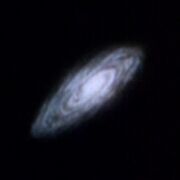mNo edit summary |
mNo edit summary |
||
| (5 intermediate revisions by 4 users not shown) | |||
| Line 1: | Line 1: | ||
[[Image:Andromeda galaxy.jpg|thumb|The Andromeda Galaxy]] |
[[Image:Andromeda galaxy.jpg|thumb|The Andromeda Galaxy]] |
||
| − | The '''Andromeda Galaxy''' is the closest spiral [[galaxy]] to the [[Milky Way]] and part of the Local Group. |
+ | The '''Andromeda Galaxy''' is the closest spiral [[galaxy]] to the [[Milky Way Galaxy|Milky Way]] and part of the Local Group. From its closest point to the [[Alpha Quadrant]] it is approximately 2.5 million light years away. Intelligent lifeforms in Andromeda include the [[Kelvan]]s, the [[Saer'nar]] and the [[Archein]]. ({{TOS|By Any Other Name}}; [[On a Knife Edge]], {{ody}}) |
| − | In [[2384]], [[Section 31]] sent [[Theseus]], aboard the |
+ | In [[2384]], [[Section 31]] sent [[Theseus]], aboard the {{Phoenix-X|uss}}, to the Andromeda Galaxy using an altered-transwarp engine, in order to gain the Kelvans as Section 31 allies. Upon entering the Galaxy, the ''Phoenix''-X was forced out of transwarp due to abnormally high radiation levels. The Kelvans chose to keep their dominant values and not accept Theseus' offer. Instead, Theseus found the Kelvans to be developing Omega molecules. Theseus then acquired a group of these molecules for himself, suspending them within an [[Omega (PNX character)|Andromedan android's]] abdomen using Kelvan technology. The ''Phoenix''-X returned home to the Milky Way safely and had the adjustments to their engine dismantled. {{ep|{{PNX}}|Forbidden Crossing, Part III}} |
| + | In [[2385]], {{uss|Cole|NCC-89204}} medical personnel discovered [[microorganism]]s from the Andromeda Galaxy like [[bacteria]] thrived on [[isolytic burst]]s and adapted to [[subspace radiation]], indicating that galaxy had higher concentrations of subspace radiation. {{ep|{{Hmd}}|Profit Without Honor}} |
||
| ⚫ | |||
| ⚫ | |||
[[Category:Galaxies]] |
[[Category:Galaxies]] |
||
Latest revision as of 06:16, 16 February 2021

The Andromeda Galaxy
The Andromeda Galaxy is the closest spiral galaxy to the Milky Way and part of the Local Group. From its closest point to the Alpha Quadrant it is approximately 2.5 million light years away. Intelligent lifeforms in Andromeda include the Kelvans, the Saer'nar and the Archein. (TOS: "By Any Other Name"; On a Knife Edge, Star Trek: Odyssey)
In 2384, Section 31 sent Theseus, aboard the USS Phoenix-X, to the Andromeda Galaxy using an altered-transwarp engine, in order to gain the Kelvans as Section 31 allies. Upon entering the Galaxy, the Phoenix-X was forced out of transwarp due to abnormally high radiation levels. The Kelvans chose to keep their dominant values and not accept Theseus' offer. Instead, Theseus found the Kelvans to be developing Omega molecules. Theseus then acquired a group of these molecules for himself, suspending them within an Andromedan android's abdomen using Kelvan technology. The Phoenix-X returned home to the Milky Way safely and had the adjustments to their engine dismantled. (Star Trek: Phoenix-X: "Forbidden Crossing, Part III")
In 2385, USS Cole medical personnel discovered microorganisms from the Andromeda Galaxy like bacteria thrived on isolytic bursts and adapted to subspace radiation, indicating that galaxy had higher concentrations of subspace radiation. (Henglaar, M.D.: "Profit Without Honor")
External links[]
- Andromeda Galaxy article at Memory Alpha, the canon Star Trek wiki.
- Andromeda Galaxy article at Memory Beta, the non-canon Star Trek wiki.
